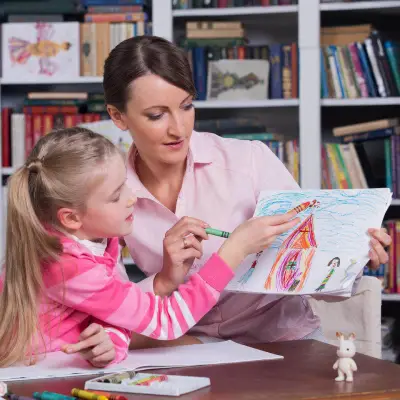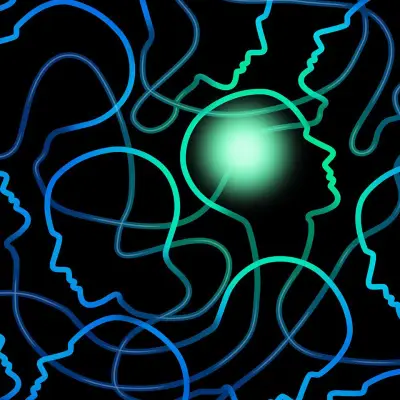In our Psychology Overview 101 blog, we explored the broad subject of psychology. As part of our ongoing series on the major subfields of psychology, we now turn our attention to developmental psychology and discover who we are and how we evolve throughout our lives.

Jump to:
What is Developmental Psychology?
Developmental psychology looks at how people change and grow over the course of their lives. Originally, it focused mostly on babies and kids, but now it covers how we develop physically, cognitively, socially, and emotionally from birth all the way through adulthood and old age. The goal is to figure out the factors that shape who we become at different stages of life.
Major theories in developmental psychology examine biology, learning, culture, and relationships. Studying normal development gives clues about abnormal development, too. Essentially, developmental psychologists are trying to find the core principles that describe human growth from infancy to the senior years.
Key Theories in Developmental Psychology
Piaget's Theory of Cognitive Development
Jean Piaget proposed that children go through four universal stages of cognitive development: sensorimotor, preoperational, concrete operational, and formal operational. He believed that children actively construct their understanding of the world as they manipulate objects, interact with their environment, and notice inconsistencies between what they already know and what they discover in their play.
According to Piaget, cognitive development is driven by the processes of assimilation, accommodation, and equilibration, as children integrate new information into existing knowledge.
- Assimilation refers to the process of taking in new information or experiences and incorporating them into existing schemas or knowledge structures. For example, a child may have a schema for 'animal' that includes fur, four legs, etc. When they see a new animal like a horse, they can assimilate it into their 'animal' schema.
- Accommodation happens when existing schemas don't work and need to be modified to account for new information. For example, when a child sees a penguin for the first time, they may realise their 'animal' schema doesn't fit, since penguins don't have fur or four legs. They must accommodate their schema to fit this new information.
- Equilibration is the drive to balance assimilation and accommodation. When a child experiences something that doesn't fit their current knowledge (disequilibrium), it drives them to restore balance by either assimilating the new information or changing their schemas to accommodate it. This constant balancing act allows the child to adapt their thinking to new experiences.
Erikson's Psychosocial Theory
Erik Erikson proposed that personality develops in stages throughout life as a result of the interaction between biologically based drives and demands from parents and culture. There are eight stages:
- Trust vs. Mistrust (infancy)
- Autonomy vs. Shame and Doubt (toddlerhood)
- Initiative vs. Guilt (nursery age)
- Industry vs. Inferiority (young childhood)
- Identity vs. Role Confusion (adolescence)
- Intimacy vs. Isolation (young adulthood)
- Generativity vs. Stagnation (middle adulthood)
- Ego Integrity vs. Despair (late adulthood)
Each of Erikson’s eight stages of psychosocial development is characterised by a psychosocial crisis between two conflicting forces. For example, during the toddler years (ages 1 to 3) the main crisis that children face is autonomy vs. shame and doubt.
The toddler is developing physically and becoming more mobile and independent. Erikson believed that if caregivers encourage this independence, children will develop confidence and self-esteem. However, if caregivers are overly harsh and try to control the toddler too much, the child is likely to struggle with shame and self-doubt. An example here might be with potty training. According to Erikson, successful completion of each stage results in healthy personality development.
Vygotsky’s Sociocultural Theory
Lev Vygotsky emphasised the critical role that culture and social interaction play in cognitive development. He proposed that children learn through social interaction with more skilled members of their culture: like parents and caregivers.
He argued that thinking has social origins and that cognitive development relies on guidance from adults until children can complete tasks independently. He also introduced the concept of “the zone of proximal development”, which refers to the difference between what a child can do independently and what they can achieve with guidance and encouragement from a more skilled partner. He believed that providing instruction within this zone, right above the child's current developmental level, can help them achieve more advanced thinking and problem-solving.
The ‘zone’ represents the ideal area for learning, where children are cognitively ready for new concepts but require some support. With an adult or peer's assistance in the zone of proximal development, the child can grasp ideas and gain competencies they wouldn’t have been able to on their own.
Bowlby's Attachment Theory
John Bowlby proposed that attachment is an evolved behavioural system that promotes survival by keeping the vulnerable infant close to the caregiver. He argued that attachment quality is based on the caregiver's sensitivity and responsiveness to the child's needs. He identified four stages of attachment that support bonding.
The four stages are;
- Pre-attachment - Birth to 3 months - infants use innate signals like crying and smiling to bring the caregiver close.
- Attachment-in-the-making - 3 to 6 months - infants recognise their caregiver and smile/coo to initiate interaction.
- Clear-cut attachment - 6 to 24 months - infants actively seek proximity and security from preferred caregivers.
- Formation of reciprocal relationships - 24+ months - children form emotional bonds beyond attachment figures.
He suggested that individual differences in attachment can significantly impact development and relationships throughout life. Securely attached infants tend to have better outcomes than insecurely attached infants.
Bandura’s Social Learning Theory
Albert Bandura's social learning theory emphasises the concepts of modelling and imitation in human learning and development. According to this theory, children (and even adults) learn a great deal simply by observing others. When they see behaviours modelled, especially by those they perceive as competent or high status, they are likely to mimic those behaviours, even if they have never displayed them before.
These observations then shape their attitudes, knowledge and behaviours. However, for observational learning to happen, Bandura said individuals must pay attention to what the model is doing, retain the behaviour in their memory, have the skills to reproduce it and be motivated to copy it. This helps to explain why we tend to pick up behaviours that are modelled by those we respect or see as rewarding.
Bandura also introduced the concept of self-efficacy, which refers to one's belief in their ability to succeed or accomplish a task. According to him, self-efficacy determines how much effort someone will put into a task and how long they will persist when faced with obstacles.
Recommended for you!
Best SellersStages of Development
- Infancy
Infancy spans the first 12-18 months after birth. Major milestones include physical growth, motor skills like grasping and walking, perceptions via the senses, cognitive abilities like object permanence, language skills like babbling and saying first words, emotions, bonding, and head control. Attachment is a key task beginning at birth. Piaget's sensorimotor stage also emerges as infants interact with their environment.
- Early Childhood
Early childhood ranges from 2-6 years old. Milestones include rapid physical growth, motor skill development like running and jumping, imagination and symbolic play, language development, socialisation with peers, gender identity and onset of logical reasoning. Key developments occur in Erikson's autonomy vs. shame stage, Piaget's preoperational stage, and Vygotsky's zone of proximal development.
- Middle Childhood
Middle childhood covers ages 7-11 and is marked by steady physical growth and improved motor skills. Cognitive changes include operational thought, memory and problem-solving improvements, and physical/social world understanding. Peers become important influences, and moral reasoning evolves. Important developments take place in Erikson's industry vs. inferiority stage as children focus on achievement.
- Adolescence
Adolescence spans ages 12-18 and involves puberty, physical maturation, and sexual development. Social and emotional growth occur as teens develop identity and relationships outside family. Cognitive changes include meta-cognition, improved reasoning and judgement. At this age, teens develop morals and beliefs while also looking for independence. This is Erikson’s identity vs. role confusion stage. Risk-taking and vulnerability also increase during this transition.
- Adulthood
Adulthood covers ages 18 to death. Physical abilities hit their peak and then slowly decline but cognitive skills like reasoning continue progressing. Erikson's stages of intimacy vs. isolation, generativity vs. stagnation, and ego integrity vs. despair occur during early, middle, and late adulthood, respectively. Other tasks include career, relationships, parenting, managing a household, and retirement, with new demands emerging at each phase of adulthood.
Influential factors in Development
There are several factors that play a role in an individual's development over their lifespan. It’s the interaction between both genetic predispositions and environmental experiences that ultimately shape development.
First, there is the “nature vs. nurture” debate. It considers whether development is dictated more by innate biological factors (nature) or environmental influences (nurture). Today, most experts agree that development involves a dynamic interaction between the two. Genetics provide potential, while environmental factors determine how much of that potential is achieved.
Secondly, there are biological influences. Things like nutrition, brain chemistry, hormones, and genetics help shape physical, cognitive, social, and personality development. Conditions like autism, bipolar disorder and Huntington’s disease all have genetic underpinnings. Biological factors can affect abilities, temperament, and vulnerabilities throughout the lifespan.
A child’s surrounding environment also significantly impacts development. Factors like their family dynamics, community, education, physical setting, nutrition, and life events all shape who they become when they grow up. Unfortunately, neglect or abuse early in life can impair development, whereas warm, responsive nurturing sets up lifelong resilience.
Socioeconomic factors can also affect child development. Status, based on family income, education, and occupation, is a strong predictor of development. For example, growing up in poverty often means facing more challenges and fewer opportunities that can negatively impact development. This can result in health problems, cognitive delays, and academic struggles. On the other hand, children raised in well-off families benefit from resources like quality food, enrichment activities, tutoring, and responsive parenting that nurtures their potential.
Finally, there are cultural influences. Children absorb the values and expectations of their culture from a young age. For example, cultures vary in terms of family dynamics and roles, like whether a culture emphasises individualism or interdependence. Gender norms also differ cross-culturally, such as different standards for assertiveness or emotional expressiveness in men and women. Even something simple like eye contact has cultural nuances that are seen as respectful in some places and rude in others!
Understanding the key theories, stages, and influences in child development provides a foundation for supporting healthy growth and progress over a lifetime. At Centre of Excellence, we offer accredited courses that provide an excellent introduction to developmental psychology, like our Psychology Diploma course for only £29 (save £98!).
For those interested specifically in working with young children, our Childcare and Early Learning Diploma equips you with knowledge of childhood development, best practices for education and care, and strategies for nurturing children’s cognitive, physical, and social-emotional growth.













